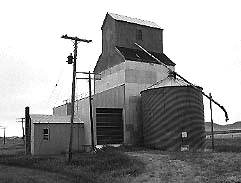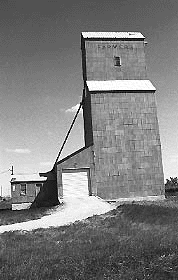Historic Architectural Survey of Bowman County
Prairie Ironclads
As John Hudson argues in Plains Country Towns, a key reason for founding so many towns at close intervals along any new railroad across the plains was to gather the produce of the agricultural countryside and bring it to transportation and market. The means of this gathering was the country grain elevator, and at the time of settlement of Bowman County, the type of elevator being built was the timber-crib, sheet-metal-clad variety. This means that the walls were laid up of two-inch boards laid flat, each layer nailed down into the previous one, and the whole was covered with stamped sheet metal. Three examples of this type of grain elevator still stand along the old Milwaukee line in Bowman County. (Unfortunately, the elevator in Rhame was destroyed by fire a few years ago.)
 | Griffin (along with Ives and Buffalo Springs) is one of those Bowman County towns that has faded away, but its grain elevator remains in service, standing just east of the town site. As with the other such elevators in Bowman County, its headhouse (the portion rising above the granary part of the elevator, accommodating the grain elevating equipment) gives the building an attractive monitor roof-line. |
| Up the road east in Scranton, the thriving Scranton Equity complex incorporates these two venerable ironclads (left). To view the grain dump and its "Dakota Maid" flour sign, go to the exhibit. |  |
 | The easternmost of these grain elevators is the one in Gascoyne, but it was not built here. The elevator was moved to Gascoyne in recent years from Marmouth, westernmost town in North Dakota on the Milwaukee line. Despite the relocation, the building retains historic integrity in that it is still used for its original purpose on the same railroad line. |
 Center for Heritage Renewal
Center for Heritage Renewal
|